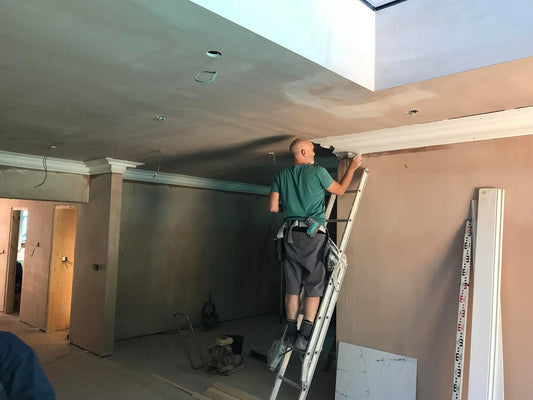How to Cut an External Mitre
This is the second video in a series of Quick Coving Tips that explain plaster coving and plaster cornice installation.
Step 1 (0:00-0:30)
A professional plaster coving installer describes in detail how to cut an internal mitre, which is for a corner that goes into a wall.
Step 2 (0:30-1:00)
Typically a mitre box is used for this, but in this demonstration, the installer shows that simply by measuring and allowing for the depth and projection of the coving a perfect internal mitre can be cut.
Step 3 (1:10-1:50
The plaster cornice is laid on a bench with the ceiling edge against the installer and the wall edge away from him.
With an internal mitre, it is important to remember that the projection measurement of the cornice is always subtracted from the top edge of the coving and the wall edge is held at the correct depth on the bench before cutting commences.
Step 4 (1:50-2:20)
Following the simple tuition guidelines, explained by the installer on two separate pieces of coving, will create a perfect 45 degree internal mitre.
Perfect does not mean without some chips or flaking caused by sawing, these disappear during the filling phase.
General tips & guidelines
- Make sure you know which edge of the plaster coving is the ceiling edge, and which edge is the wall edge
- An external mitre means that you need to 'add on' to the top edge
- Make sure you make the 'wall mark' and then square it up along the bottom edge
- Add the top edge mark of the cornice using the projection measurement
- The cut in the plaster coving will go from the bottom edge to the top edge
- Enlist the help of a spare pair of hands to hold the coving at the correct projection depth
- Cut using a saw to achieve the correct 45 degree mitre
- Repeat the process for the other end of the coving.
To find out the materials we use for this installation, see below:
- Plaster Coving
- Coving Installation Tools
- Coving Sample Pack
- Coving Adhesive
-
Need help?
View articles and videos designed to help you make the right choices when purchasing and installing products from Plaster Ceiling Roses.
-
Help Guides


